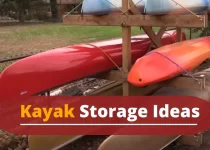What are Kayak Made Of | Uncovering the Secrets Of 2023
Kayaks are small, lightweight boats for various water activities, such as fishing, touring, and recreational paddling. This boat is usually made for sports and adventurous activities.
Usually, kayaks are made of durable materials designed to withstand exposure to elements like sun, wind, hard stones, and fast water.
The material used to make a kayak is one of the most critical factors that affect its performance, durability, and longevity. The most common materials used for kayak construction include plastic, fiberglass, carbon fiber, and hardwood. All types of fabric have unique properties and benefits, making it more critical for kayakers to choose a product that suits their needs, wants, and preferences.
All kayak materials have different properties and features. Plastic kayaks are the most affordable and lightweight, making them an excellent choice for recreational paddling and beginners. While FiberGlass and carbon fiber-made kayaks are expensive, they offer improved speed and performance.
Whether you are a beginner or an experienced kayaker, you must understand the different materials used to make kayaks to help you make an informed decision when choosing a kayak that is right for you.
As I mentioned above, there are some commonly used kayak materials and their importance, but you need to find out what kinds of kayaks are used according to their needs. Each one has its pros and cons. Let’s take it one at a time and explain each one.
Types of Materials Used in Kayak Construction
The materials used in kayak construction play a crucial role in determining the kayak’s durability, stability, and overall performance. Each material has unique properties and benefits, so it is important to choose a kayak made from a material that fits your needs and preferences.
The design and concept behind kayaks have been around for over 2000 years, with the Inuit people of the Arctic region being the first to build a kayak. These early kayaks were made of sealskin stretched over wooden or whalebone frames and used for fishing, hunting, and fast travel. While the materials used to construct kayaks have changed over time, the basic design remains the same.
Today’s kayaks are made from various materials, including plastic, fiberglass, carbon fiber, and wood, each offering its own unique benefits and drawbacks.
Whether you are interested in speed, stability, or affordability, a kayak is made from a material that will meet your needs and wants.
Now we have explained kayak materials in detail.
Inflatable and folding kayak material
Inflatable and folding kayaks are popular choices for those looking for a portable and convenient option. These kayaks are made from heavy-duty, puncture-resistant materials, such as PVC or nylon, which can withstand exposure to the elements and provide excellent durability.
The main advantage of inflatable and folding kayaks is that they are easiest to transport and store, making them ideal for those who want to take their kayaks camping.
Inflatable kayaks can be quickly inflated and deflated while folding kayaks can be compactly folded into a small size for easy storage.
Although they may be slower or perform less well than traditional kayaks, they offer the convenience of portability and ease of storage, making them a popular choice for many kayakers.
Folding kayaks
Folding kayaks offer a unique blend of portability and performance, making them a popular choice for kayak lovers who want a kayak that is easy to transport and store. However, it is still performing well on the water.
There are two main types of folding kayak construction:
- The skin on the frame
- collapsible single sheet
Skin-on-frame kayaks use an aluminum or wooden frame that folds or disassembles for storage, with a flexible, watertight “skin” of polyurethane, synthetic rubber, or nylon stretched over the edge to form the hull and deck.
Single-sheet collapsible kayaks are made from twin-layer polypropylene plastic sheeting that is creased to allow for easy folding and interlocking.
Although folding kayaks do not have built-in bulkheads, they should be equipped with airbags or buoyancy for touring on open or moving water. Some manufacturers also offer hybrid folding inflatable kayaks that incorporate skin-on-frame construction and inflatable tubes for added stability and floatation.
Advantages
- Easy portability and storage
- rival traditional kayaks in performance and durability.
- Patch kits for minor tears should be included.
- Superior gear storage compared to inflatable kayaks
Disadvantages
- require more maintenance
- prone to mold and mildew if not stored properly.
- They vary widely in cost, with some models costing more than composite kayaks.
- Assembly and disassembly can be more challenging compared to inflatable kayaks.
Inflatable kayaks
Inflatable kayaks provide a convenient solution for those with limited storage and transportation space. These kayaks are rubbery and can be easily packed into a duffle bag or backpack.
These kayaks come in various designs, from simple tubes to complex models incorporating drop stitch construction, baffles, and other fused air chambers for greater rigidity, puncture resistance, and better hull shape design.
The choice of material for inflatable kayaks involves finding the right balance between strength, weight, cost, and environmental sustainability.
Choosing the best material for inflatable kayaks can be difficult, but weighing factors such as kayak strength, weight, cost, and other considerations such as environmental sustainability makes sense. The three most common materials used for inflatable kayaks are:
PVC: – PVC is the most commonly used material and is relatively lightweight and inexpensive. However, it is prone to UV damage and releases toxic chemicals throughout its lifecycle, making it the most environmentally harmful of all plastics.
Nitrylon: – Nitrylon, a laminate of synthetic nitrile rubber and polyester fabric, is an eco-friendly alternative with better longevity than PVC.
Polyurethane: – Polyurethane, also known as TPU, is a high-performance material with an excellent strength-to-weight ratio, flexibility, UV stability, and resistance to abrasion, mildew, and extreme temperatures. Polyurethane is also environmentally sustainable and can be recycled at the end of its life.
The cost of an inflatable kayak ranges from about the same as that of a rotomolded kayak to more than that of a composite kayak. At the high end, bombproof, self-bailing inflatables are suitable for extreme whitewater paddling, while feature-rich models with covered decks and gear storage are ideal for touring.
On the other hand, simple and inexpensive inflatables from big-box retailers are only suitable for sheltered waters.
Advantages
Advantages of kayaks made from materials like polyurethane or TPU:
- lightweight and affordable.
- easy to repair with readily available repair kits.
- Flexible and portable due to the soft, rubber-like material
- can be folded for convenient storage and transportation.
Disadvantages
Disadvantages of kayaks made from materials like polyurethane or TPU:
- vulnerable to punctures and UV damage.
- can be affected by extreme temperatures and prolonged sun exposure.
- PVC materials used in kayaks may not be environmentally friendly.
- Inflatable kayaks have a higher risk of developing mold and mildew.
Hard Shell Kayak Materials
A hard shell kayak is a type of kayak constructed with a rigid, hard exterior made from various materials such as plastic, fiberglass, and other composites. The rugged body provides increased durability and stability, making it popular for recreational and touring kayaking.
The choice of material depends on the specific needs and preferences of the kayaker.
Whether you are looking for a kayak for casual paddling or more challenging conditions, there is a hard shell kayak made of a suitable material for you.
Here we list different hard-shell kayak materials and their properties in detail.
Wooden kayaks:- are a popular choice among do-it-yourself home builders. Unlike the kayaks you can buy from big retailers, these are unique and handmade. There are two common construction styles available.
Stitch and glue:- The stitch and glue method is faster to assemble and does not require any prior woodworking experience. It involves stitching precut plywood pieces together with wire, gluing the seams with epoxy resin, trimming the wire, covering the kayak in fiberglass, and polishing it with a UV-resistant varnish finish.
Strip-built: – On the other hand, the strip-built method offers unlimited design freedom but requires more patience and woodworking experience.
Building a wooden kayak is a great way to enjoy the natural beauty of the wood while having a kayak that performs as well as advanced composite kayaks. The low cost of building it yourself is also a big bonus, allowing you to have a high-quality boat at a fraction of the price of polyethylene kayaks.
Advantages
Advantages of wooden kayaks:
- unique and traditional appearance
- lightweight and structurally efficient
- robust and sturdy
- Ideal for DIY enthusiasts and woodworkers
- Flexibility in designing
- a cost-effective alternative to composite kayaks.
Disadvantages
Disadvantages of wooden kayaks:
- time-consuming and requires woodworking skills.
- can be more expensive to buy than composite kayaks.
- not suitable for rocky or whitewater environments.
- Limited options exist for adding flotation devices and sealing bulkheads.
Thermoform kayaks
Thermoform kayaks offer a balance between polyethylene and composite kayaks that provide the best of both worlds. Thermoform kayaks use an advanced plastic laminate construction that combines the affordability and durability of plastic with the lightweight and aesthetic appeal of composite materials.
The thermoforming process uses a vacuum to wrap heated plastic sheets around kayak molds, allowing for finer lines and more complex shapes while using less material than traditional roto molding.
The result is a lighter kayak that is also structurally strong. The deck and hull are thermoformed separately and then joined together, resulting in a seamless finish.
Although the plastic sheet material used in the thermoforming process is a fusion of impact-resistant plastic and glossy acrylic, which gives the kayak a shiny, scratch-resistant, and UV-resistant finish,
Whether you are looking for a premium recreational kayak, a lightweight fishing kayak, or an expedition-ready touring kayak, there is a thermoform option to suit your needs and budget.
Advantages
Advantages of Thermoform Kayaks:
- more durable and scratch-resistant than polyethylene kayaks.
- lightweight and cost-effective compared to composite kayaks
- UV-resistant outer layer for a glossy finish
- easier to repair than other kayak materials.
Disadvantages
- degradation of the UV-exposed ABS base layer over time, even with proper maintenance.
- need for indoor storage or upside-down outdoor storage to prevent damage.
- vulnerability to shattering in cold temperatures with hard impacts
- Limited availability of thermoformed kayaks from manufacturers
Composite kayaks
Composite kayaks are those types made from a mixture of high-tech synthetic fabrics such as fiberglass, aramid fibers, carbon fiber, or a combination of all these. Some kayak manufacturers add foam or honeycomb cores between the fabric layers to provide extra rigidity.
The difference between these materials is just weight and cost, with the lightest materials being the most expensive. There are three types of materials used in composite kayaks.
Fiberglass:– Fiberglass is the most popular composite material due to its strength and weight ratio and its affordability.
Aramid Fiber:- While aramid fiber offers similar strength and rigidity, it is lighter and more expensive.
Carbon Fiber:- Carbon fiber is the lightest and costliest composite material, typically used for sports and racing kayaks.
Moreover, these kayak types are built using a gel coat, sprayed into the separate deck and hull molds, followed by hand-laid layers of cloth bonded by the resin. Kayak vacuum bag technology ensures the resin is injected and distributed more quickly and evenly than hand pressing the layers.
Although composite kayaks are more expensive than plastic ones, they are more efficient to paddle, with sleeker lines and a faster, more responsive performance on the water. The longevity of composite kayak materials makes them a good investment, as they can last a paddler’s whole career.
Advantages
Advantages of Composite Kayaks:
- lightweight construction with an excellent strength-to-weight ratio.
- superior performance, responsiveness, and efficiency compared to plastic kayaks.
- ability to repair scratches, spider cracks, and punctures with minimal tools and self-education.
- UV resistance with smooth scratches from abrasions that do not affect hull speed
Disadvantages
Disadvantages of Composite Kayaks:
- Hardshell kayak material is the most expensive.
- Because of its stiffness, it is vulnerable to severe cracks and punctures from direct hits.
- There is a risk of damage from surfing into rocks or navigating through rocky rivers.
- There is the possibility of encountering outdated designs and outfitting in used composite kayaks, as well-cared-for models can still perform for decades.
Polycarbonate kayaks
Polycarbonate kayaks have become a popular trend on ocean and river tours and in local waterways. The clear kayaks have a see-through hull and deck made of sheets of polycarbonate, also known as Lexan, a thermoplastic that can be molded into complex shapes without cracking or breaking.
Polycarbonate kayaks are manufactured using vacuum thermoforming, making the hull even more robust than standard thermoformed kayaks. The high-sided, transparent hull and open sit-on-top design make kayaks ideal for recreational touring on calm waters.
However, polycarbonate kayaks usually lack a deck to shed water or bulkheads for floatation. They also often incorporate a simple aluminum frame to add rigidity to the hull.
Overall, polycarbonate kayaks provide a unique paddling experience and offer a glimpse beneath the hull of a kayak.
Final Thought
I conclude that the choice of kayak material and design plays a crucial role in determining the performance and functionality of the boat. Factors such as the kayak’s intended use, ease of repairs, and long-term commitment to kayaking must be considered when selecting it. The market offers various options, from low-cost recreational kayaks to high-performance boats made from advanced materials.
When making a purchase, it is crucial to consider the cost, weight, durability, and performance of the boat to make a well-informed decision. It is also essential to have a good understanding of selection to make a lasting and favorable decision. Whether a beginner or an experienced paddler, having the right kayak can enhance your paddling experience and help you pursue your passion.
FAQs
What plastic are ocean kayaks made of?
Ocean kayaks are often made of a type of plastic called polyethylene. This material is durable, lightweight, and UV resistant, making it a popular choice for ocean kayaks. It can also be manufactured in different densities to offer varying rigidity and impact resistance levels.
How much weight can a plastic kayak hold?
The weight capacity of a plastic kayak varies depending on the model and specifications, but on average, most plastic kayaks can hold between 250 and 400 pounds. It’s essential to check the manufacturer’s specifications to ensure the kayak can safely carry the weight of the paddler and the gear.
How long can plastic kayaks last?
Plastic kayaks can last several years with proper care and maintenance, but the lifespan can vary depending on factors such as frequency of use and storage conditions.


